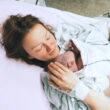Fertility Awareness-Based Methods (FABMs) have come a long way from your grandmother’s rhythm or calendar method. In the second half of the twentieth century, researchers made tremendous strides in understanding how daily observations of a woman’s cervical mucus, basal body temperature, and urine samples can help women understand their fertility and gain insights into their overall health.
Fertility science isn’t stopping there. As we step further into the twenty-first century, technology is expanding into every area of contemporary life, with healthcare not the least of it.
In a recent webinar sponsored by the International Institute for Restorative Reproductive Medicine, speaker David Wither discussed the monumental changes healthcare is seeing in light of new technology, especially among young people. Wither is a retired manager of Philips’ global telecom team for mobile devices in the U.S. and Europe, current president of the Board of the St. Raymond Nonnatus Foundation, and a member of the Mental Illness Council of the National Catholic Partnership on Disabilities (NCPD), and he suggests new players in the medical industry want to do to healthcare what Uber did to taxis.
Young women in particular are increasingly turning to the Internet and social media for the way they care for their health. Femtech is an up-and-coming field, and in addition to the many apps that are available for charting today, wearable devices are coming to the fore as a major player in women’s health.
In the broader realm of health services, data from wearable devices is being used in clinical trials to render more accurate results. Having more efficient access to healthcare professionals also means providers can intervene earlier, provide better preventative care, and offer real-time therapy and treatment for improved quality of life.
As far as fertility awareness, Wither reports Fitbit’s estimate that 24% of U.S. adult women are currently using a fertility app, which translates to over 14 million women. These apps include Glow (10 million women), Natural Cycles (900,000 women), and FEMM (400,00 women).
Those familiar with FABMs may be legitimately concerned that women are attempting to practice these methods without the benefit of a trained FABM instructor, relying solely on the technology and anecdotal evidence from online forums for information. The other side of the coin is that the apps’ and devices’ algorithms are adding thousands, if not billions, of data points to their knowledge stores every day. The more data available to the software, Wither says, the better the analysis.
Moreover, predicts Wither, “With millions of wearable devices collecting and uploading data, progress will not only continue, but accelerate.” The data collected will drive research and potentially “disrupt current sex education and NFP practice models.” The question is what that will look like one, five, and ten years down the line.
It is critical that FABM organizations develop means of incorporating this technology into their teaching and user access, to stay current with demand. Wither suggests that FABMs “as a marketplace of specific methods/practices, will evolve into systems that use every ‘bit’ of symptom data that can be automatically captured and analyzed.”
We’re currently seeing women express interest in understanding their cycles, turning away from hormonal birth control and its harmful side effects. But we need to be sure women are given access to more than an app or a device. Real power is in knowledge of how our bodies work on a day-to-day basis, and the ability to make decisions about our health based on those findings.
As the technology improves, Wither encourages the growth of a culture that “integrates the best and honors those who drive change which improves the quality of life.” FABM organizations must commit to learning how to excel in the online world of millennials, the iGen, and Gen Alpha. They must adapt to the learning and information-access habits of the under-30 and even under-20 audience to stay relevant and serve this population well.
There is money to be made in the world of femtech, but companies must keep in mind that people—women, men, and children—are at the core of their work. Young women’s reliance on technology doesn’t negate their interest in understanding more about their bodies and good health. Advances in femtech will mean innovation and creativity, and must have the dignity and respect of the human body at its core to do justice to the gift of fertility. While the technology is fascinating, the true work of art is the human body itself.







